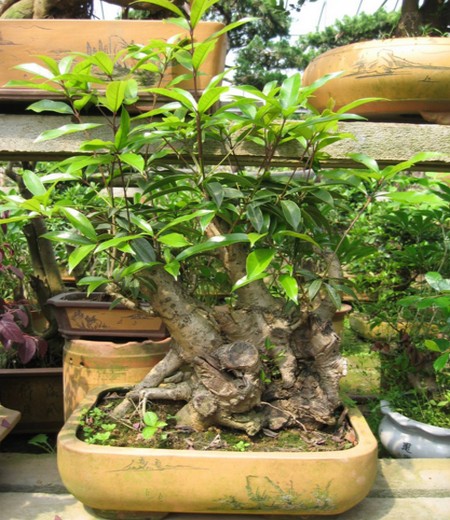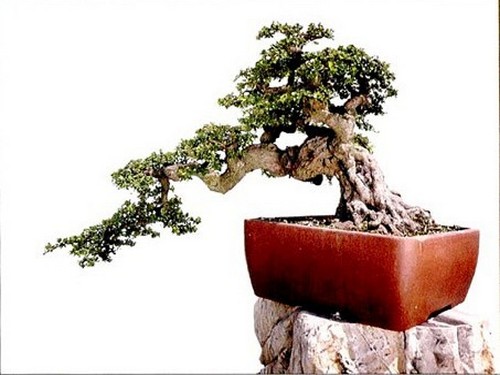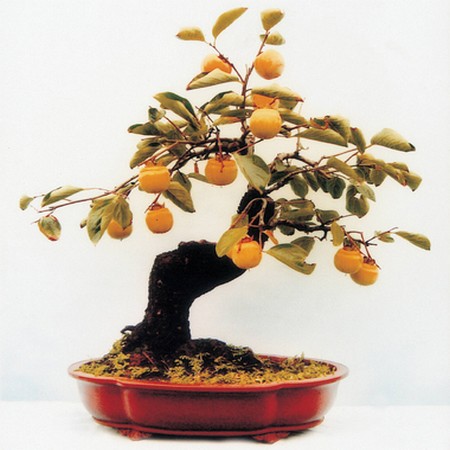Making method of bonsai with stone of sweet-scented osmanthus
In principle, the production of sweet-scented osmanthus bonsai requires far-reaching composition; learning from natural reality; developing strengths and avoiding weaknesses; combining dynamic and static dexterity; unified coordination and eye-pleasing; small and medium-sized insights; appropriate density; clear primary and secondary eye-catching. The bonsai with stone of sweet-scented osmanthus inherited and carried forward the tradition of Lingnan School, imitating nature, shrinking dragon into inch, cutting dry and storing branches and other techniques for production. The biggest feature of stone-attached bonsai is that the stone is soft and soft, which forms a lively and lively masterpiece with both shape and spirit.

1. Selection of stone attached to sweet-scented osmanthus
To pick the shape of tall and thin, grooves, potholes, hollow stone, and strive to "thin, wrinkle, leak, transparent". "thin" means that the stone has edges and corners, and it is suitable to prepare arc peaks; "wrinkle" means that the texture is clear, wrinkle but not messy, such as the folds of mountains; "leakage" means that the stone has pores that can be ventilated and drained; and "through" means that there are pores in the stone, like natural rock caves, with a sense of peace and quiet. The soft stone with loose texture is commonly used, and the other is the hard stone, such as quartz stone, stalactite, sand stone, tortoise stone, yellow wax stone and so on. Most of the stone bonsai have deep textures or caves and many stone gaps, which can show the beauty of ugly, strange and strange forms. It can be processed by sawing, carving and cement bonding.
2. Selection of sweet-scented osmanthus modeling tree.
Stone-attached sweet-scented osmanthus should choose sweet-scented osmanthus trees with soft and developed roots, thick and easy to grow. Choose sweet-scented osmanthus trees with fast-growing roots, long trunks and suitable thickness. Tree posture planting method can be straight, oblique, mostly alone. The production time is from March to June or September to October. Shallow pots should be used for planting. In addition, in the combination of trees and stones, the image and size of the stone body are required to be coordinated with the posture, height and height of the trees.
3. Making bonsai with stone of sweet-scented osmanthus
(1) the principle of production. The production techniques of stone-attached bonsai should follow the principles of sticking, sticking, sticking and masonry. The shape varies from stone to stone, and the trees are exquisite and curved on the stone. First, taboo roots are separated from stone, non-sticky, loose and weak; second, taboo roots are not embedded in solid stone seams, non-sticky, non-masonry, and have roots without power; third, taboo roots are disorganized, affected, and lose their natural beauty; and four taboo branches will be far-fetched and lose the characteristics of boulder tree roots. (4)
(2) production techniques. The main methods of making sweet-scented osmanthus bonsai are top planting stone-wrapped type, stone-riding holding type, winding climbing type, stone-dependent attachment type, cave embedding type and so on. The forms are as follows: first, the roots are exposed, clinging to rocks and rocks, and the tree trunks are straight and straight; second, the tree roots are rooted in the cracks in the rocks, and the trunk is mechanical barium tablet, flying in the wind; third, the tree roots grow between the stone cliffs, and the tree trunks are Qiu qu straight into the cliff, majestic.
(3) the production process. After the stone and tree materials are selected, the selected 3-5 trees with well-developed lateral roots are planted in a deep and high basin and cultivated in a loose semi-mud coarse sand loam. After determining the theme and layout, according to the natural texture, several grooves are cut according to the number of coarse roots. The bottom of the stone is fixed and stable with cement, the stone is shaped, and the appearance is used to determine the appreciation surface of the shape. Then fix the trunk in a suitable position, tie it with glue rope, fix it while binding, adapt to it, hold the rock, the branch support is evenly distributed, and make the root and stone stick tightly. Finally, put the whole scene in a tile basin, surround the stone with thin splint or cardboard, surround the joint of the tree and stone, fill it with mud, insert the mud with bamboo branches, make the pond mud firm the root system, facilitate the absorption of water and nutrients, and drench the fixed root water, then the production is completed. Two years later, when the tree is strong and thick, remove the mud, move the attached stone to a shallow basin suitable for appreciation, trim and remove the messy roots, let the roots be exposed in the sun and dew, accelerate their development and growth, and make the roots hide and show, rely on and rely on, and embed solid stone seams; the trunk falls to the branch receptacle positioning modeling, according to the growth of the tree, continuous pruning. The longer the time, the better the work.
Time: 2019-05-26 Click:
- Prev

The method of making Fujian Tea Bonsai
Fujian tea is produced in Guangdong, Fujian, Taiwan and other provinces in southern China. It is also distributed in the tropics of southern and southeastern Asia. Fujian tea, also known as base tree and cat tree, is an evergreen shrub of Arnebiaceae. The leaves are small, long oval, dark green and shiny. White florets bloom in spring and summer, drupe globose, red after green. It has a rugged trunk.
- Next

The method of making persimmon bonsai
Persimmon bonsai trunk ancient strange, strong twists and turns, oblique dry, the branches are empty, natural and orderly. A multi-stem uneven height, hanging roots and claws, branches and leaves sparse, unique, spectacular and deep. The straight curve between the stem and the branch changes and stretches freely, which not only embodies the interest of the mountains and forests, but also has a unique artistic flavor. The young branches are bright green.
Related
- Fuxing push coffee new agricultural production and marketing class: lack of small-scale processing plants
- Jujube rice field leisure farm deep ploughing Yilan for five years to create a space for organic food and play
- Nongyu Farm-A trial of organic papaya for brave women with advanced technology
- Four points for attention in the prevention and control of diseases and insect pests of edible fungi
- How to add nutrient solution to Edible Fungi
- Is there any good way to control edible fungus mites?
- Open Inoculation Technology of Edible Fungi
- Is there any clever way to use fertilizer for edible fungus in winter?
- What agents are used to kill the pathogens of edible fungi in the mushroom shed?
- Rapid drying of Edible Fungi

